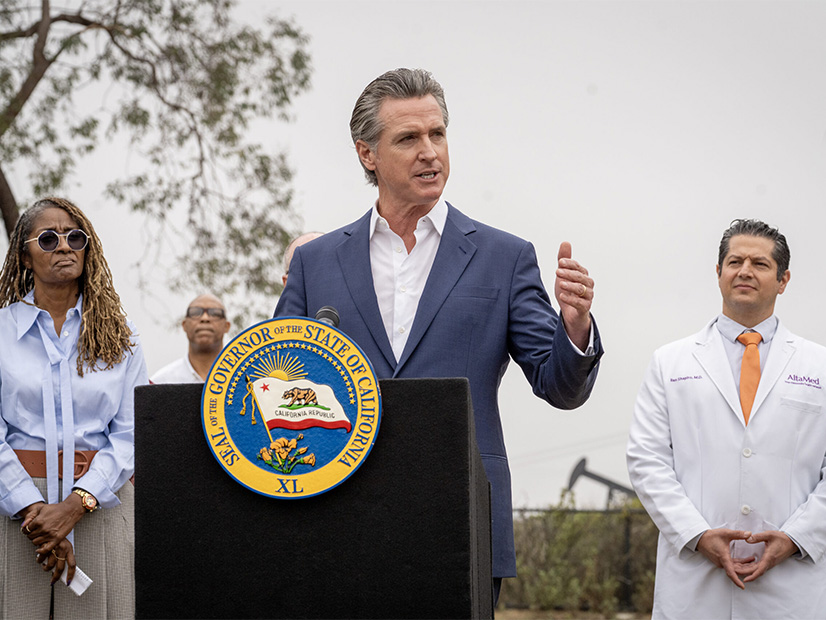
California Gov. Gavin Newsom has signed a bill to streamline approval of transmission projects by removing a requirement for regulators to evaluate non-transmission alternatives such as demand-side management.
Assembly Bill 2292, by Assemblymember Cottie Petrie-Norris (D), is just one in a bevy of bills the governor signed into law in the days leading up to a Sept. 30 bill-signing deadline. Other new laws relate to bi-directional EV charging, industrial energy use and hydrogen fueling stations.
Proponents of AB 2292 said the bill makes a modest but important change to the California Public Utilities Commission approval process for transmission projects.
The bill removes a requirement for the CPUC to consider cost-effective alternatives to transmission facilities “that meet the need for an efficient, reliable and affordable supply of electricity.” Those alternatives may include demand-side options such as targeted energy efficiency or ultraclean distributed generation.
Requiring the CPUC to review alternatives duplicates work done by CAISO in identifying the need for the project as part of its transmission planning process, supporters said.
The new law comes as the CPUC is updating its General Order 131-D to make the permitting process for transmission projects more efficient and consistent. (See CPUC Works to Revamp Tx Permitting Rules.)
Bi-directional Charging Bill
Another bill signed by Newsom could lead to a requirement for electric vehicles to be equipped for bi-directional charging.
Senate Bill 59, by Sen. Nancy Skinner (D), authorizes the California Energy Commission (CEC) to require any size class of battery EV to be capable of bi-directional charging — if there is a “compelling beneficial” use case for both the EV operator and the electrical grid.
“Bi-directional capabilities in BEVs have the potential to improve customer energy reliability, resiliency and demand management during electric grid stress events while supporting our state’s transition to zero-emission transportation,” Newsom said in a bill-signing message.
The governor’s message noted the complexities of aligning BEVs with the bi-directional charging equipment, while factoring in electric rates and potential grid effects.
Another Petrie-Norris bill signed by the governor is AB 2779, which promotes the use of grid-enhancing technologies. The bill requires CAISO to report any new use of GETs that it deems reasonable, along with the cost savings and efficiency of that technology, when it approves a transmission plan.
GETs are a way to expand the capacity of the grid much more quickly than building new transmission, which can take years. They include advanced reconductoring and other technologies.
The governor previously signed SB 1006, by Sen. Steve Padilla (D), which requires utilities to study the feasibility of using GETs. (See California GETs Bill Gets Newsom’s Signature.)
RA Requirements
Another bill signed into law is Petrie-Norris’ AB 2368, which addresses electric system reliability.
The bill, sponsored by the Clean Energy Buyers Association, requires the CPUC to adopt a 1-in-10 loss of load expectation (LOLE), or a “similarly robust reliability metric,” when setting resource adequacy requirements. (See Clean Energy Buyers Push Passage of New Calif. Reliability Law.)
The bill also requires the CPUC to determine whether measures are needed to reduce the costs to ratepayers of a resource adequacy program.
A bill sponsored by the California Nevada Cement Association also received Newsom’s signature. AB 2109, by Assemblymember Juan Carrillo (D), will exempt large industrial customers from paying their utility a departing load charge if they use waste heat to generate their own power.
The bill will make industrial process heat recovery cost effective and advance the state’s efforts to decarbonize manufacturing, CNCA Executive Director Tom Tietz said in an opinion column.
Hydrogen Fueling Stations
SB 1418 by Sen. Bob Archuleta (D), which the governor signed, is intended to speed up local government permitting of public hydrogen-fueling stations.
Cities and counties are already required to streamline the permitting process for EV charging stations. SB 1418 will extend that streamlining by requiring cities and counties to adopt an ordinance and checklist for permitting hydrogen-fueling stations.
Archuleta noted in a release that the Department of Energy has awarded up to $1.2 billion to California’s hydrogen hub, the Alliance for Renewable Clean Hydrogen Energy Systems (ARCHES).
“Success hinges on rapidly scaling up hydrogen-fueling infrastructure and vehicle development,” the release said. “California cannot achieve its zero emission goals without success at the local level.”


